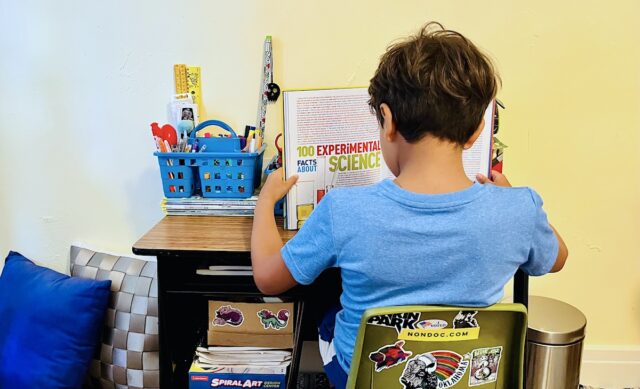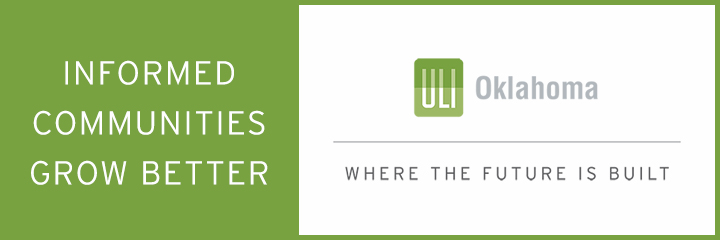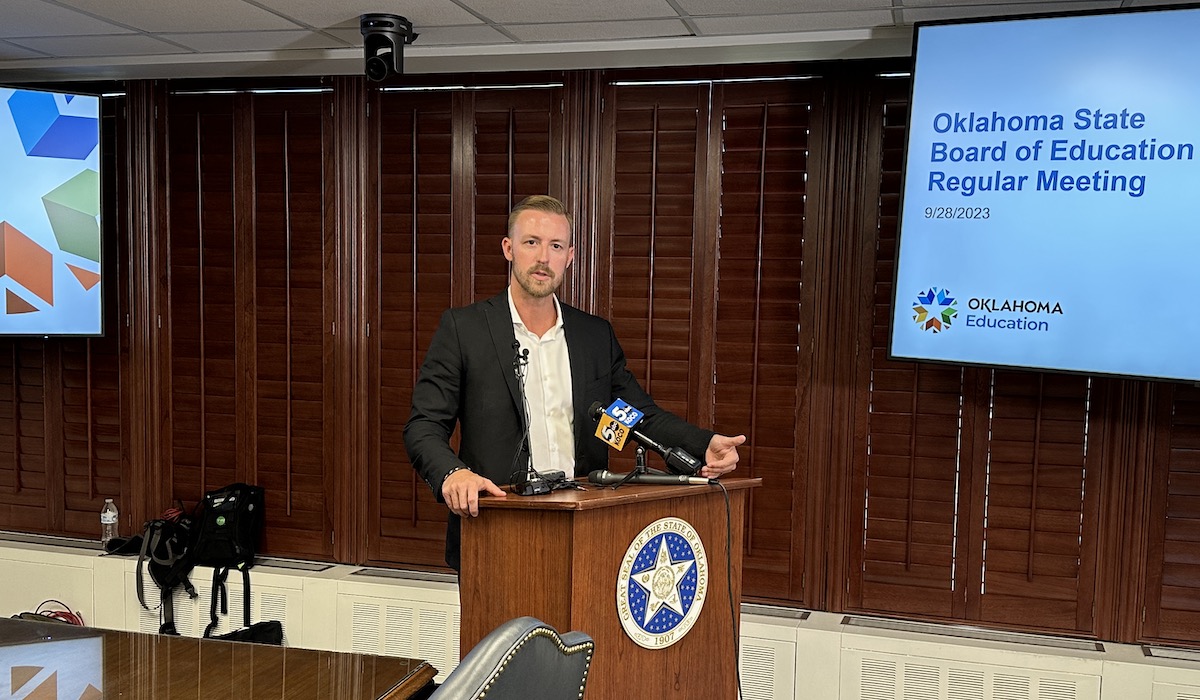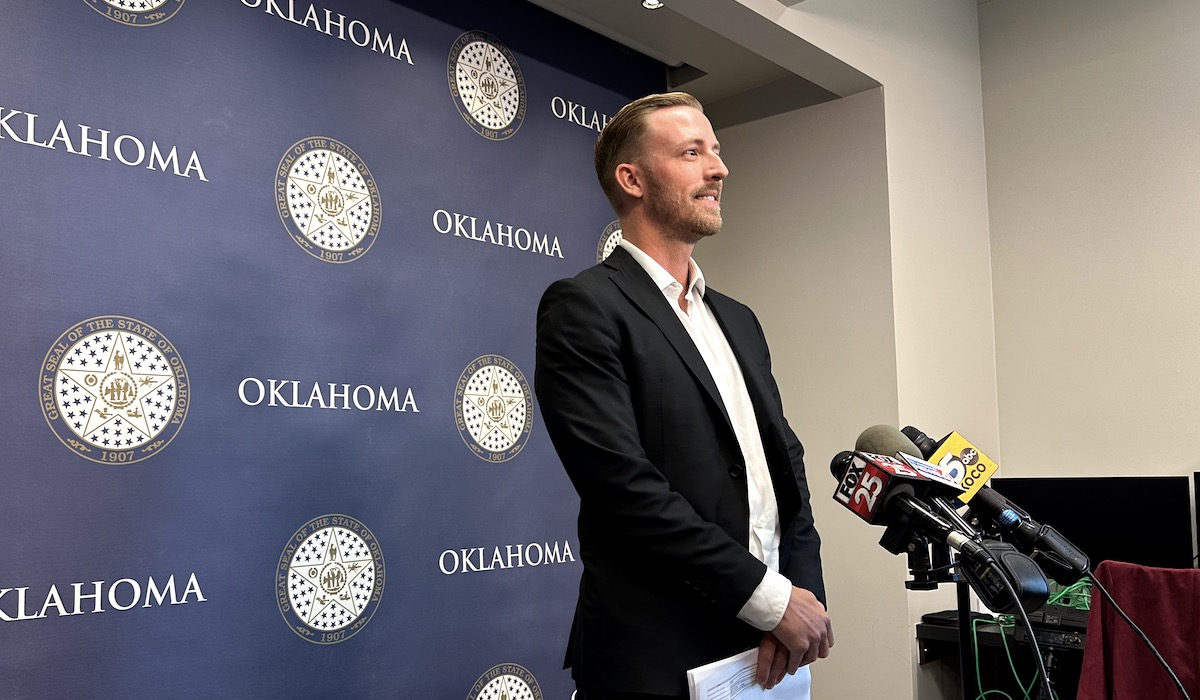

When former public school teacher Lucia Frohling read her elementary-age daughter’s journal one day after summer school, her heart broke.
“I’m stupid,” the young girl had written. “I’m an idiot, and I don’t want to be on Earth.”
Going into fourth grade, Frohling’s daughter was reading on a kindergarten level. Multiple efforts at intervention and extra help from teachers in Deer Creek Public Schools had failed, leaving her confidence “shattered.” Frohling said she knew her daughter was smart, but every time she asked administrators in Deer Creek Public Schools to help in the way she knew was needed, she said she encountered resistance.
After finally getting the district to accept that her daughter had dyslexia in addition to her dysgraphia, a type of writing disorder, Frohling asked Deer Creek to use the Take Flight intervention program, which is designed to teach students with reading and writing disabilities via practices developed from a body of research known as the “science of reading.”
While not a curriculum itself, the broad concepts under the science of reading umbrella use disciplines such as neuroscience and psychology to create an understanding of how kids learn to read and how brain processes allow it to happen. Typically, curricula using science-of-reading research emphasize more phonics instruction and sequential, explicit guidance on how to decode words and sentences.
When Frohling and Deer Creek Public Schools could not reach an agreement on using the Take Flight intervention for Frohling’s requested 45 minutes each day, Frohling moved her daughter to Trinity School at Edgemere, a private school for kids with learning disabilities whose teachers are trained in structured literacy, a curriculum similar to the Take Flight intervention program that also uses practices derived from the science of reading. Frohling’s son, who also has dyslexia, was already enrolled at Trinity.
“[She] now reads on a second-, third-grade level after one year. She no longer has suicidal ideation,” Frohling said, adding that her daughter now wears her disabilities proudly.
‘Reading is foundational’

Data and anecdotal stories indicate that Frohling’s experience can be common.
According to the 2022 Nation’s Report Card, 45 percent of Oklahoma fourth graders tested below the basic reading level. Just 24 percent are at or above proficient. Nationally, 37 percent of fourth graders are below the “basic” benchmark in reading.
For years, these numbers have been dismal at the state and national levels, and Oklahoma’s scores have dropped over the past 25 years. In 1998, 34 percent of Oklahoma fourth graders were below the basic reading level. Nationally, 40 percent of fourth graders fell below that standard.
The fourth-grade metric is important. Many reading experts emphasize the importance of ensuring kids know how to read by third grade, which is roughly when students transition from learning to read to reading to learn.
Since he took office, State Superintendent of Public Instruction Ryan Walters has made improving Oklahoma’s reading scores one of his core priorities, but his clashes with legislators and his focus on culture-war divides have left little air in the room for breathing life into reading pedagogy.
Nonetheless, the topic is one Walters wants to discuss, and he has worked to amplify the existing Science of Reading Academies program created in 2021 by his predecessor, Joy Hofmeister, as a way to address sagging reading scores during the pandemic.
“Reading is foundational,” Walters said. “I think we have to do this. I think for our kids to be successful, for us to win on education, for us to be a leader, for us to have the type of education systems our kids deserve (…) it has to start with reading and reading comprehension.”
Like many others in literacy curriculum circles across the country, Walters has hailed the science of reading as the solution to address low reading scores. He is not the first. The movement supporting the science of reading saw a push in the early 2000s before losing momentum, but recent national coverage has given it new life. While politicians like Walters use the term copiously and call for its widespread adoption in classrooms, others say it is simply too general to “adopt” as a silver bullet to fix reading scores.
.@JayOBTV reports on the challenge some students face learning to read in America’s schools, speaking with the parents, teachers and students working to improve how reading is taught. pic.twitter.com/77O16BUC9y
— ABC News Live (@ABCNewsLive) September 8, 2023
“When you talk about the science of reading, that’s actually a very broad term that encompasses a lot of different research,” said AJ Griffin, a former state senator and current CEO of the Potts Family Foundation, which prioritizes early childhood development as a focus area. “So, when the State Department (of Education) uses that term, I’m not 100 percent sure which body of research they’re referring to.”
Despite disagreements over the definition of the science of reading, most literacy experts agree that something needs to change to improve reading scores, and most tend to agree that any change needs to incorporate evidence-based practices for literacy instruction.
To that end, Walters requested $100 million from the Oklahoma Legislature this spring to implement a science-of-reading-based program statewide, and he recently argued in favor of using science-of-reading practices when discussing Tulsa Public Schools’ low reading scores.
Although lawmakers eventually included $10 million in their massive education package for a three-year pilot program of literacy specialists, Walters’ $100 million request was not granted by the Legislature. But Walters is already preparing to push the topic again next session and continue shifting the Oklahoma State Department of Education toward science-of-reading-based practices to teach literacy across the state.
‘Feedback from teachers has been overwhelmingly positive’
While the Reading Sufficiency Act has been in state statute since 1997, it has been amended several times since. Legislators and OSDE have also drafted new laws, rules and programs to help train teachers in practices derived from the science of reading.
In 2021, OSDE created the Science of Reading Academies to give teachers training in an intensive program called Language Essentials for Teachers of Reading and Spelling (LETRS). As the state’s superintendent of public instruction at the time, Hofmeister dedicated $13 million of federal pandemic relief funding to the effort, which had a goal of training 10,000 elementary educators by 2024.
Two years later, despite Walters often criticizing his predecessor, he has continued support for the program within OSDE.
“Through [the Science of Reading Academies] we have offered an intensive professional development for teachers dealing specifically with grades K through three,” Melissa Ahlgrim, OSDE’s program director of early literacy policy programs, said in an interview this summer. Our feedback from teachers has been overwhelmingly positive.”
That positive feedback could be essential for continuing to implement science-of-reading practices. For some teachers who learned other methods or who relied on other popular approaches for years, it has been difficult to make the shift and accept that the way they taught reading for years could have been less effective, Ahlgrim said.
“Change is very scary, and it is very emotional,” said Ahlgrim, a former teacher. “When you’ve been doing something like teaching kids, and then somebody comes along and tells you what you’ve been doing — it’s not helping your kid — we as teachers take that very personally.”
To that end, officials with OSDE and other experts stress that poor reading scores are caused by a variety of factors.
“It’s not a teacher’s fault,” Walters said. “They went through a college of education or attended a training and were told the wrong thing. But now we’ve got to make sure we bring the proper attention to it and go, ‘Guys, hey, we’re here to help.’ And that’s what I want them to hear from the State Department.”
Complicating his message to teachers, however, has been Walters’ near-constant rhetoric that rubs some educators the wrong way. This year, Walters has called teacher unions a “terrorist organization” and has perpetuated what some have called a culture of fear in some school districts.
‘Admitting you’ve got a problem’

Many advocates for better literacy instruction, including Walters, argue that the cause of poor reading scores lies in a lack of evidence-based reading instruction in classrooms across the nation — in other words, a lack of practices derived from the science of reading.
One method of teaching reading that had been popular for decades came from Lucy Calkins, a Columbia Teachers College professor who traveled the country training educators in her curriculum, which districts across the country use either fully or in part. The program focused more on fostering a love of reading and writing in students instead of on giving students explicit instruction in decoding words. Recently, however, that approach has received scrutiny, and Calkins herself added more phonics to her method before the Teachers College dissolved her organization last month.
Calkins’ popularity grew from an area of need. Many teachers across the country who received little instruction in how to teach reading from their universities have been eager to implement methods taught to them by a prestigious Teachers College professor.
Frohling was one such teacher. In her first year in the classroom, her school brought in Calkins’ “writing workshop” to provide teachers a better way to instruct students. While she was excited to learn, Frohling said trying to implement the curriculum provded less effective than she had hoped.
“It wasn’t magical,” Frohling said, noting that her experience left her interested in other methods of teaching reading that her daughter would eventually use.
Walters has been quick to heap blame on colleges for not teaching better methods to future educators.
“We have to just address this as a problem that has occurred both because of higher ed and because of folks that don’t have this training and background. I haven’t met a single teacher that I’ve talked to who doesn’t want to be a great reading instructor,” Walters said. “The first part of fixing a problem is admitting you’ve got a problem.”
According to the National Council on Teacher Quality, none of Oklahoma’s 12 elementary education programs have an “A” grade for literacy instruction. Just three — the University of Oklahoma, Cameron University and Langston University — have “B” grades. Five programs have “F” grades.
The NCTQ review graded programs based on the number of scientifically based reading instruction components they cover. As programs include less science-based instruction or more instruction contrary to the science, their ranking is downgraded.
At OU, students in the Jeannine Rainbolt College of Education who study early childhood education take a class on language and literacy development. Jiening Ruan, a professor in the college’s instructional leadership and academic curriculum department, said OU has become “more intentional in equipping our pre-service teachers with critical knowledge of reading research and research-based instructional practices and strategies.”
“In our courses, we emphasize the critical role that explicit and systematic instruction of phonemic awareness and phonics plays in beginning reading,” Ruan said in a statement emailed to NonDoc. “They also have opportunities to evaluate multiple state-adopted literacy curricula using their knowledge of research-based reading instruction and identify strengths and areas that may need supplementation. Our approaches to literacy instruction have always been informed by the latest research in reading and literacy.”
For years, many teachers across the country have relied on some variation of a curriculum known as “balanced literacy” to teach students to read. That curriculum incorporates a number of reading instruction practices teachers can use to teach students to read based on individual student needs. However, the approach has been criticized recently owing to its lack of emphasis on phonics and its supposed reliance on having students guess what word they’re reading.
Many districts in Oklahoma and across the country use Calkins’ method, balanced literacy or similar programs, either in their entirety or as aspects of instruction. Deer Creek, for instance, has a mixed program, even though its teachers are trained in Structured Literacy Basics.
Frohling, who no longer teaches, is now the director of parent services at Every Kid Counts Oklahoma, a controversial and reform-focused organization that was led by Walters until after he was elected state superintendent. Following questions about how Walters and EKCO handled federal COVID relief funding, the organization’s website displays an overhaul of staff and only two remaining board members.
Frohling said she uses her personal experience and expertise to help other parents of kids with disabilities as they navigate the complicated landscape of Individualized Education Plans in public schools.
She said that, although many students can learn to read with curricula such as balanced literacy and Calkins’ “writing workshop,” methods that do not incorporate and emphasize explicit and sequential instruction in decoding words will always leave a significant percentage of students behind, particularly those with learning disabilities like dyslexia.
“If you teach all children the way dyslexics can be taught and should be taught and need to be taught, everyone can learn,” Frohling said. “But if you teach balanced literacy, and it’s not systematic and explicit, then you’re leaving out at least 20 percent of the population, if not more.”
‘Nothing more heartbreaking’
Tammy Dillard is the director of the teaching and learning team at the Oklahoma Public School Resource Center. She described five “big ideas” of literacy instruction:
- Phonological awareness,
- Phonics,
- Vocabulary,
- Fluency, and
- Comprehension.
Dillard said it is a misconception to think of those five ideas as sequential, meaning pre-K students begin with phonological awareness and third-grade students round out their literacy instruction with comprehension. Rather, good reading teachers should incorporate all five ideas throughout a student’s literacy education, she said.
“All five big ideas are in the car, and when the student is in pre-K, phonological awareness is the idea that’s driving, but the other big ideas are still in the car. You’re still reading aloud to that 4-year-old and developing comprehension skills, and you’re still working on nursery rhymes and developing some fluency,” Dillard said. “As the child grows, the driver changes, but all the big ideas are still in the car.”
She said understanding good literacy instruction is important, as many teachers and education experts take a step back to evaluate why reading scores have been so low for so long.
Walters stressed the need for real solutions as soon as possible.
“There’s nothing more heartbreaking than when you deal with a high school kid who can’t read,” Walters said. “By that point, their confidence is so shot. (…) It’s heartbreaking.”
Even science-of-reading advocates have reacted with caution to OSDE’s new push for literacy reform. Dillard said that while teacher-training programs are important, they must be ongoing to be effective.
“If I’m a principal in Oklahoma today and I send my first-, second- and third-grade teams to go get this training in implementing the science of reading, and then they come back to school and there is no ongoing support, no instructional coaching, no real effort to make sure that it’s making it beyond the training window, then we really are not going to see the results that everybody really aspires to see,” Dillard said.
But some early childhood experts say that even if curricula involving science of reading practices are well-implemented, improving literacy can still be a challenge owing to factors outside the classroom.
“If we look at the gaps we have in achievement around reading among Oklahoma school kids, that gap is actually created before they ever arrive in school in communities that are under resourced,” said Griffin. “There’s a very clear link in the literature between what happens in the first five years of life — and even before they’re born — and how well they perform once they get to school.”
Griffin acknowledged the importance of the science of reading but said classroom practices can only go so far in addressing developmental gaps in children.
“Lack of socialization is part of it, and then isolation of families that don’t have access to the resources or the experience that really prepare kids for school,” Griffin said. “There’s a direct link between school performance and the vocabulary used in a home, access to books at a very young age, regular health care access.”
Earlier this year, Griffin became CEO of the Potts Family Foundation, a prominent philanthropic organization that focuses largely on child welfare. Promoting evidence-based literacy and numeracy is one of the foundation’s four focus areas in its OK25by25 campaign that aims to improve Oklahoma’s childhood wellbeing rankings.
Griffin emphasized the need for families to address pre-literacy skills with their kids before they ever get to the classroom.
“If we don’t address the gaps in those milestones of learning before they get to school, the techniques to teach reading in school are really kind of irrelevant,” Griffin said.
$100 million? Try $10 million first

Legislative leaders would seem to agree with Walters’ goal of improving literacy for students via science-of-reading-based practices. As part of a massive education funding package, they appropriated $10 million for a three-year pilot program for elementary school reading specialists, a fraction of the amount than Walters’ requested $100 million for a broad program.
Outlined in SB 1118, the appropriation will establish a “literacy instructional team” consisting of 15 members trained in “the science of how students learn to read” who will be placed in regions across the state to assist districts with improving students’ literacy outcomes.
“We want to be able to set up sustainable systems that help schools know how to use their data, to identify student needs, and match that with the type of instruction that those students need to be successful,” Ahlgrim said. “While also doing that, (the team will be) setting up those processes so that schools who we’re not able to work with right now could still have step one, step two and step three for, ‘Here’s how you can go about setting this up in your schools as well.'”
Ahlgrim and Walters said the new law is important to help improve student literacy rates, and legislators who drafted the law requiring team members to be trained in the science of reading clearly agree.
But partly owing to his divisive style, Walters had little overall influence on the 2023 session’s education negotiations, according to House Appropriations and Budget Education Subcommittee Chairman Mark McBride.
“Although some of the Legislature may not be totally against what he’s done, I think everybody is concerned, and they have concerns about how the agency is being run and how the money is spent,” said McBride (R-Moore).
McBride, who was part of the education funding negotiations, explained that the Legislature was partly unwilling to grant $100 million to just “one thing,” but members were also hesitant to appropriate that money specifically to Walters’ agency.
“The Legislature’s not going to turn him loose with $100 million because we don’t know what he’ll do,” McBride said.
Walters time as state secretary of education and director of Every Kid Counts Oklahoma included administration of millions of dollars of federal GEER funds, a topic that has drawn interest from FBI agents and the Oklahoma Attorney General’s Office, according to people with direct knowledge of the inquiry.
McBride’s comments echo the sentiments of many in Oklahoma’s education sector who fear Walters’ advocacy for the science of reading could do as much harm as good to the movement owing to his polarizing nature.
For his part, Walters said he is not worried about the possibility his education rhetoric could affect his reading reform goals. As he pushes for science-of-reading practices in classrooms, the state superintendent billed his efforts as in line with his overall goals for OSDE.
“A lot of what I talk about is reforming the education system,” Walters said. “Some of the hardest things of being a messenger of change and reform is that people just generally are like, ‘Hey, I’ve been doing this 15 years.’ It’s tough to admit there’s a better way of doing it.”
While many of Walters’ other efforts at reform — including advocating for school choice and getting what he calls “indoctrination” out of schools — have seemed to divide the education world and provoke the ire of education leaders, some science-of-reading advocates say the movement has enough momentum to sustain itself both with Walters’ support and despite it.
“I certainly don’t think that this volatile situation is helping anything,” Dillard said. “But just in all fairness, I wouldn’t be able to lay the resistance, the implementation of the work, at the foot of any politician.”
Frohling echoed a similar sentiment.
“I don’t think [Walters] will do more harm than good. However, I am fearful that those who don’t support him — that no matter what he says — they’ll turn their focus on whatever they don’t agree with rather than the good,” Frohling said. “However, I think there’s a rising tide with the dyslexia awareness — with the dyslexia awareness training, with the dyslexia screeners — with all of these other things that have gone into play (…) I think that there’s enough other voices to say this is the right thing to do.”
Walters said science-of-reading-based practices should be the sort of topic that can be supported by Oklahoma education advocates across the board.
“No matter what you think about me — doesn’t matter if you agree with me on everything — let’s put the kids first and make sure that our kids are getting the best education possible,” Walters said.




















